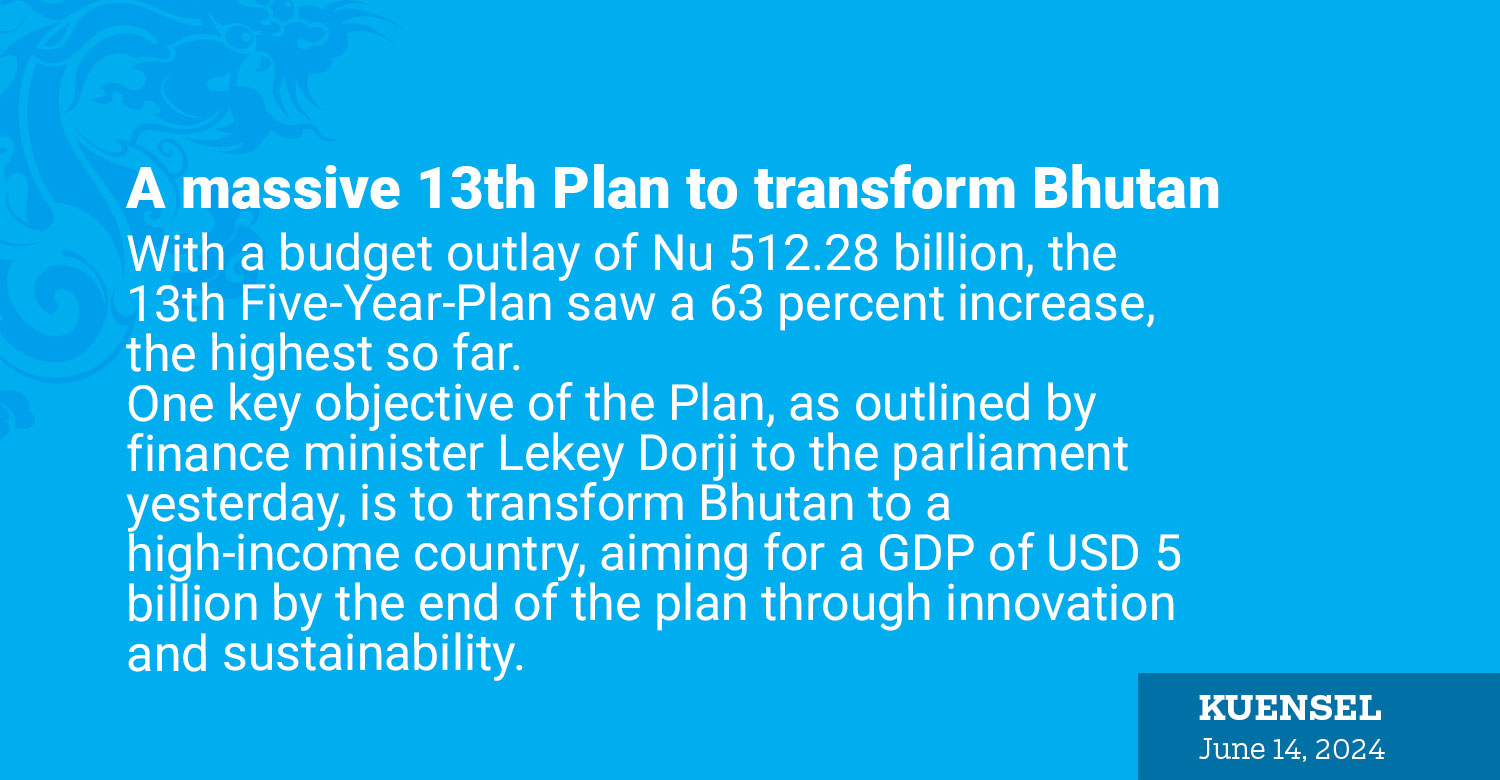
Government targets transition to high-income economy by 2029
With a budget outlay of Nu 512.28 billion, the 13th Five-Year-Plan saw a 63 percent increase, the highest so far.
One key objective of the Plan, as outlined by finance minister Lekey Dorji to the parliament yesterday, is to transform Bhutan to a high-income country, aiming for a GDP of USD 5 billion by the end of the plan through innovation and sustainability.
Out of the total budget outlay, Nu 456.34 billion is projected as available resources, while the remaining Nu 55.93 billion will be covered by deficit financing. Domestic revenue is expected to contribute Nu 327.34 billion and Nu 125 billion from grants.
The current expenditure is estimated at Nu 267.28 billion, primarily allocated for pay, allowances, and interest payments on hydro-loans.
Capital expenditure, amounting to Nu 245 billion, will be financed through a combination of revenue surplus (24.5 percent), grants (51 percent), and concessional external and domestic borrowings (24.5 percent).
The 13th Plan focuses on creating a healthy and productive society through equitable access to health, education, and social protection. It also aims to strengthen national sovereignty, territorial integrity, security, unity, wellbeing, resilience, and economic prosperity.
Lyonpo Lekey Dorji highlighted the strategic approach aligned with international commitments such as the Sustainable Development Goals (SDGs), human rights instruments, and environmental agreements.
According to the minister, the Plan adopts a four-cluster approach to enhance coordination and collaboration across economic, social, security, and governance sectors, in line with the public sector transformation initiative from 2022.
This plan supports eight national programmes designed to deliver specific outcomes and outputs crucial for sustainable development. On the economic front, the government targets a substantial GDP growth to USD 5 billion, with a per capita GDP exceeding USD 6,174 by 2029.
It includes key strategies in enhancing productivity, diversifying markets, and boosting contributions from strategic sectors to GDP.
Similarly, in the social sector, the government aims to improve health outcomes, expand education access, and establish a comprehensive social protection system through community engagement and systemic reforms.
The government will further focus on mitigating threats, managing disaster risks, and safeguarding critical infrastructure, while also promoting Bhutan’s cultural identity and global reputation.
Good governance remains a major focus of the government, with initiatives aimed at transforming the public sector into a dynamic, results-oriented entity.
This includes deploying data-driven policies, strengthening digital infrastructure, and enhancing the effectiveness of state institutions in delivering transparent, citizen-centric governance.
The projected fiscal deficit for the 13th Plan is Nu 55,938 million, equivalent to 2.97 percent of GDP.
According to the report, external borrowing will be the primary source of financing, with a focus on securing highly concessional funds from institutions like the Asian Development Bank (ADB) and the World Bank (WB).
In addition, domestic funds will be raised through government bonds and treasury bills to achieve a balanced strategy for meeting the fiscal deficit. According to the report, the public debt is estimated at Nu 474,419.06 million by the end of the 13 Plan, which is approximately 94.8 percent of estimated GDP.
The majority of this debt, Nu 392,673.04 million will be external, with hydropower debt accounting for 73.3 percent and non-hydropower debt accounting for 26.7 percent of total external debt.
Similarly, domestic debt is estimated at Nu 81,746.02 million (17.2 percent of total public debt) and external debt is projected to decline from 92.9 percent to 78.5 percent of GDP by the end of the plan period, with non-hydro external debt representing 21 percent of estimated GDP.












